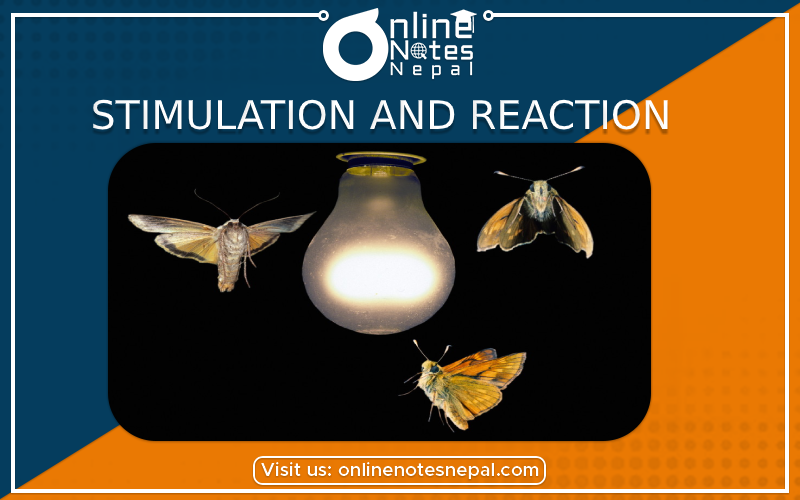Published by: Nuru
Published date: 06 Jul 2021

The physical source which allows showing response is called the source of stimulation and reaction the movement which is shown by an organism.
The process of inducing any living organisms to show some response is called stimulation. The physical source which allows showing response is called the source of stimulation and the movement which is shown by an organism in response to the source of stimulus is called reaction.
The movement is shown by organisms(plants and animals) in response to the external stimulus is called taxis. There are two types of taxis, they are:
The movement shown by organisms(plants and animals) in response to light is called phototaxis. Its stimulus is light. There are two types of phototaxis, they are:
a. Positive phototaxis:
The movement shown by organisms(plants and animals) towards the light is called positive phototaxis. Swimming of Euglena towards light, Insects, and butterflies flying directly towards tube light e.t.c. are positive phototaxis.
b. Negative phototaxis:
The movement shown by organisms(plants and animals) away from the light is called negative phototaxis. Growth of fern, orchid in the shaded region, living of earthworms, and cockroaches in dark places are negative phototaxis.
The movement shown by organisms(plants and animals) in response to chemicals is called chemotaxis. Its stimulus is chemicals. There are two types of chemotaxis, they are:
a. Positive chemotaxis:
The movement shown by organisms(plants and animals) towards chemicals is called positive chemotaxis. Movement of antherozoids and the ovum of fern towards the malic acid released from ovum is positive chemotaxis.
b. Negative chemotaxis:
The movement shown by organisms(plants and animals) away from chemicals is called negative chemotaxis. Repelling mosquitoes against burning anti-mosquito mats or coils is negative chemotaxis.
Enzymes
The biological catalyst which helps in digestion is called an enzyme.
Goiter
The disease caused due to deficiency of iodine which results swallowing of the thyroid gland is called a goiter.
The response shown by different parts of a plant (roots, stem, leaf, e.t.c.) is called tropism. There are two types of tropism, they are:
The response shown by different parts of a plant (roots, stem, leaf, e.t.c.) in response to light is called phototropism. There are two types of phototropism, they are:
a. Positive phototropism: The response shown by different parts of a plant (roots, stem, leaf, e.t.c.) towards the light is called positive phototropism. Stem and leaves are directed towards light and are positive phototropism.
b. Negative phototropism: The response shown by different parts of a plant (roots, stem, leaf, e.t.c.) away from the light is called negative phototropism. Roots of plants grow into the soil it is negative phototropism.
The response shown by different parts of a plant (roots, stem, leaf, e.t.c.) in response to gravity is called geotropism. There are two types of geotropism, they are:
a. Positive geotropism: The response shown by different parts of a plant (roots, stem, leaf, e.t.c.) towards gravity is called positive geotropism. Roots of plants move downward it is positive geotropism.
b. Negative geotropism: The response shown by different parts of a plant (roots, stem, leaf, e.t.c.) away from the gravity is called negative geotropism. The shoot of the plant grows upward and shows negative geotropism.
The response shown by different parts of a plant (roots, stem, leaf, e.t.c.) to water is called geotropism. There are two types of hydrotropism, they are:
a. Positive hydrotropism:
The response shown by different parts of a plant (roots, stem, leaf, e.t.c.) towards water is called positive hydrotropism. Roots of plants grow towards the water it is positive hydrotropism.
b. Negative hydrotropism:
The response shown by different parts of a plant (roots, stem, leaf, e.t.c.) away from water is called negative hydrotropism. The shoot of a plant grows in an upward direction and shows negative hydrotropism.
The response shown by different parts of a plant (roots, stem, leaf, e.t.c.) to the chemical is called chemotropism. There are two types of chemotropism, they are:
a. Positive chemotropism: The response shown by different parts of a plant (roots, stem, leaf, e.t.c.) towards chemical is called positive chemotropism. Pollen moves towards the style because of the chemical stimulus on stigma and it is positive chemotropism.
b. Negative chemotropism: The response shown by different parts of a plant (roots, stem, leaf, e.t.c.) away from the chemical is called negative chemotropism. Tendrils bending away from the chloroform contraction of the tentacle of sundew when liquid protein is placed in the middle of the leaf and shows negative hydrotropism.
The response is shown by different parts of a plant (roots, stem, leaf, e.t.c.) to heat, and the temperature is called thermotropism. There are two types of thermotropism, they are:
a. Positive thermotropism:
The response shown by different parts of a plant (roots, stem, leaf, e.t.c.) towards heat, and the temperature is called positive thermotropism. Some flower-like tulip opens at higher temperatures and it is positive thermotropism.
b. Negative thermotropism:
The response shown by different parts of a plant (roots, stem, leaf, e.t.c.) away from heat, and the temperature is called negative thermotropism. Tulip closes at lower temperatures and shows negative thermotropism.
The response is shown by different parts of a plant (roots, stem, leaf, e.t.c.) to touch is called thigmotropism. There are two types of thigmotropism, they are:
a. Positive thigmotropism:
The response shown by different parts of a plant (roots, stem, leaf, e.t.c.) towards touch is called positive thigmotropism. Tendrils wrap on support and it is positive thigmotropism.
b. Negative thigmotropism: The response shown by different parts of a plant (roots, stem, leaf, e.t.c.) away touch is called negative thermotropism. The plant Mimosa Pudica (Touch me not) closes when we touch it and shows negative thigmotropism.